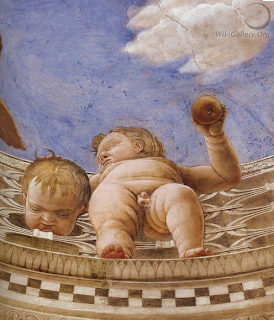"Sketch of a Bison" by Henri Gaudier-Brzeska demonstrates the term Contour Line by in this sketch he indicates the edge of a three dimensional form. The contour lines around the bison show how his horns and legs come out further in different areas. Henri has multiple sketches that show great examples of contour lines including the example in the book of the Female Nude Back View pg 57.
Implied Line
Implied line is a function of line of sight, a direction in where figures given a composition are looking. Alberto Giacometti's Trois hommes qui marchent I is an example of implied line because how the two outside individuals are facing towards the person in the center. How the outside individuals have a slight lean at the waist and their heads are facing the center like they are looking at the middle person, as well as their legs are arched and in front of one another as if they are walking towards the middle individual.
 Expressive Line
Expressive Line Expressive line is defined as A kind of line that seems to spring directly from the artist's emotions or feelings loose, gestural, and energetic. Vincent Van Gogh's Straw Hat is a great example of expressive line because you can see how all the tiny lines in the work, all pieced together to make a man wearing a straw hat.
Expressive line is defined as A kind of line that seems to spring directly from the artist's emotions or feelings loose, gestural, and energetic. Vincent Van Gogh's Straw Hat is a great example of expressive line because you can see how all the tiny lines in the work, all pieced together to make a man wearing a straw hat. One Point Linear Perspective
In a One point linear perspective lines are drawn on the picture plane in such a way as to represent parallel lines receding to a single point. In Duccio's Maesta you can see the perspective being focused on the virgin Mary and baby Jesus, How you can tell this perspective is by looking at all the lines focusing on the center for example the groves on the pillars and the second floor railing focusing right on Virgin Mary's head.

Axonometric Projection
Axonometric projection is a type of parallel projection used to create a pictorial drawing of an object, where the object is rotated along one or more of its axes relative to the plane of projection. Theo van Doesburg creates this in De Stijl by making the drawing at an almost 45 degree angle looking down at the object and having the lines run at a parallel projection.
Foreshortening
Foreshortening is when a artist makes the dimensions of the closer extremities adjusted in order to make up for the distortion created by the point of view. In Andrea Mantegna's Ceiling Oculus she makes the babies feet actually smaller than they should be so his feet do not look over sized or bigger like a comic book which is not like how a picture in real life would make the babies feet look. Foreshortening is done so we can see the whole picture than one big object to focus on such as feet for example.



No comments:
Post a Comment